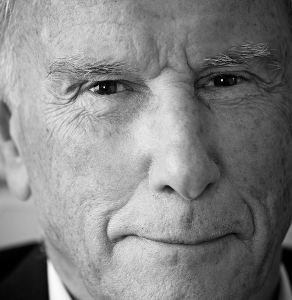Profile

Breaking new ground
It’s obvious from the first five minutes of talking to Simon Barrow that his background is in advertising. Tall, silverly handsome and old enough to be of the generation that is coy of their age, Barrow’s avuncular manner belies his quick wit and dedicated curiosity. The man who first developed employer brand management concepts is quick to bring forth the facts, the figures and the contemporary case studies to back up any of the points he raises. He delivers them with a Mad Men style long practiced in the agency pitches of his younger days.
Barrow started his career, however, in brand management. At Colgate Palmolive, he was brand manager for Colgate Fluoride – the Big Red. He was happy with the way his career was progressing, and then, shortly after turning 32, Colgate asked him to join the global management team, with the added attraction of becoming general manager of the Benelux office.
As Barrow recalls, “I thought, what does that mean? Do I want to be an international gypsy? Do I want to end up in New York? Most importantly, what were the chances of ending up on Colgate’s board? I checked. It’s changed now, but back then there wasn’t a single Brit.”
Barrow decided it was time to leave to leave Colgate, making a conscious decision to bring his brand management experience into advertising. He joined Charles Barker, a corporate advertising agency, arguably the oldest in the world. It was a formidable presence in 1972, with a fledgling consumer goods practice that Barrow started to grow. Within four years he was made its CEO.
The next ten years were spent expanding the agency. He put to use what he had learned from Colgate, but also continued his own personal development, “I learned a great deal about the communications business, about hiring, firing, developing, winning; all the things you do if you have to run a service business whose life blood is new business.”
Barrow needed to distance the consumer-facing work that his arm of the agency was producing from the more financially-oriented work from the rest of Charles Barker. He took part of the name of the company’s American partner, NW Ayer, to form Ayer Barker.
NW Ayer was the oldest agency in America, and was behind some of the most globally recognised campaigns, from ‘A diamond is forever’ for De Beers to AT&T’s ‘Reach out and touch someone.’
“IT MIGHT SURPRISE THE HR PROFESSIONAL, BUT OUTSIDE THE WORLD OF ORGANISED CRIME, WHICH ACTUALLY HAS VERY FEROCIOUS VALUES, MOST BUSINESSES ARE LEGITIMATE BUSINESSES AND ARE RUN HONESTLY”
According to Barrow this rebranding was crucial for the success of the agency, “It was my first, definitive, piece of branding and with it came the beginnings of my understanding of the employer brand. The kind of folk I was looking to recruit came from the big name agencies: Y&R, JWT, Ogilvy etc., not from the world of the City. So Ayer Barker became the first time a decent consumer ad agency had emerged from City roots.”
Ayer Barker was eventually sold to NW Ayer, and Barrow was moved across to another Charles Barker division, Barker Human Resources, the recruitment advertising arm of the agency.
Barker Human Resources was a giant, an advertising factory spewing out over a 100,000 job ads per year and responsible for over 6m copies of what then were called house newspapers.
Although highly profitable, Barrow found this role frustrating. “I thought it was reactive. The key dimensions were following the client’s brief, saying it graphically, at an acceptable price with a quick turnaround. Where was the strategy in the world of work?”
Unable to turn away from his history of brand management he started to apply coherent thought to the work the agency was producing. “In about 1989, I suddenly realised it was something else. It’s an employer brand. The same principles apply; the principles are good planning, good research, creativity, inspiration, coherent execution and good measurement. Those are the perennial bases for good brand management of anything.
Over the following year, Barrow further defined his employer brand management model and in 1990 he delivered a speech on what is now regarded as the unveiling of the employer brand concept.
Making reference to the 26-year-old Proctor & Gamble marketer who, in 1932, was credited with creating the concept of brand management, I asked Barrow if he thought this was a ‘Neil McElroy moment.’ It’s clear that McElroy was something of a hero to him.
Barrow says, “I’ve often thought, would that I could be like him. He was a remarkable man. He was 26, he had come out of Harvard, he was working for Proctor and he wrote a five-page memo on what turned out to be brand management. The rule, policed rigorously, was that memos had to be on one page, so he broke that. By 44, he was Proctor’s CEO. Many people don’t know what happened to him after that. He fought in World War II and became Eisenhower’s secretary of state for defence. So he had it in him to lead.”
Barrow returns to the subject of McElroy later, when we are discussing whether employer brand management is able to attract the right calibre of people. He says, “There are a number of remarkable people, who should enter the marketing and communications world and yet choose to do other things. I often wonder if people like Neil McElroy would still go into Proctor & Gamble today? I suspect they would, because it is still a remarkable employer, 80 years later.” He is less certain of whether the brightest people are drawn to employer brand management in other companies. “Not enough of that talent goes into this area. There seem to be limits to people’s aspirations. A few years ago, I did some research on what employment brand managers aspire to be. The answers were: group head of employer brand management, leave to start a consulting company, become head of corporate affairs and more at that level. But no one has ambitions of joining the board or becoming CEO. Surely such a great function should be able to celebrate its own alumni?”


With over 20m Google search results, university degree courses and dedicated management teams focused on it, employer branding has become a ubiquitous term in the branding phrasebook. Yet it was first heard less than 25 years ago. Andrew Thomas caught up with Simon Barrow, the originator of the term and the godfather of employer brand management
One of Barrow’s problems with marketing, communications or human resources having responsibility for employer brand management is that those departments are not often part of a company’s senior management. “Most people with the title employer brand manager, when you press them they are responsible for doing enough research to find something compelling to say about their business, but they are not in any way responsible for changing the business. My belief is you start employer brand management at the top. If senior management doesn’t want to get involved, walk away.”
Interestingly, his views on the role of senior management in employer brand management seem to be taking hold. Australia-based consultancy Employer Brand International has produced a report called ‘The Rise of Employer Brand Leadership’ for the past five years. The global survey, now covering 1,900 companies, has seen senior management taking an increasing responsibility over the employer brand. The latest research report, published in October 2013 saw the chief executive taking responsibility in 19% of organisations, compared to only 1% in 2009. Similarly the executive has seen growth from 2% to 12% over the same period.
While the figures are encouraging, Barrow is fearful of complacency. “Brand management is in pretty good shape in what used to be called FMCG and in the B2B market. But in the world of work there is still much to be done. I felt that was the case in 1989 and I still feel that now.”
It is clear that there is an element of disappointment from Barrow over what has been achieved. At one point he says he had hoped employer brand management would have emerged as a more powerful discipline by now. The largest problem, he says, are the forces of conservatism in human resources and in marketing and communications. “I think it’s because people, particularly on the supply side, have a living to earn. They don’t get paid until there is a commission to hire somebody. So the extent of what they want is a bit of research or a website, particularly as it means they won’t have to involve lots of other people. It takes courage again to say ‘Well hang on a second, I can go further that.’”
Barrow says you can tell when the CEO of an organisation has limited involvement in the employer branding by just a cursory look at its values. He did some research in this area recently and the most frequently used terms amongst FTSE 100 firms were integrity, honesty, trust and teamwork. Barrow says, “If all a company can say about itself is that it is honest, what is it actually saying? Is it highlighting a dishonesty amongst everyone else its sector. It might surprise the HR professional, but outside the world of organised crime, which actually has very ferocious values, most businesses are legitimate businesses and are run honestly.”
Having created the employer brand management concept, Barrow has defined it further. Together with Tim Ambler, a fellow of the London Business School, he published an academic paper in the Journal of Brand Management in 1996. By this time, Barrow was running People in Business, a consultancy practice he launched under Barker Human Resources, and bought from the agency in 1992. He sold it to an American firm in 2002, but remained its chairman until 2007. The last seven years have’t seen him quiet down, however. He remains active, and indeed was keen to introduce me to the management of Westbourne Communications, a public affairs consultancy for whom he is working to develop its employer brand proposition, and in whose boardroom the interview takes place. Despite nearly 50 years in brand management he has no intention to retire. A week after our interview, he calls to say he had just heard the news that branding genius Wally Olins had died. He says, “If I had known this when we met, I would have said I would hope to be able to keep making a contribution as long as he did.”
Simon Barrow believes in values that can be measured. His values are:
Humanity
“You shouldn’t be in this work if you don’t care deeply about people. Everyone says they do, but do they really?”
Curiosity
“What do you read every day? Do you read the Economist, the Spectator, the New Statesman? What daily papers or websites do you read? How often do you send someone an email with a question just because you are interested in what they do.”
Energy
“You need an extraordinary amount of energy to do this work. It’s not a 9-to-5 role.”
Projection
“You need to be a bit of a revolutionary. You need to seize the opportunity to express your point of view and demonstrate your talent.”












